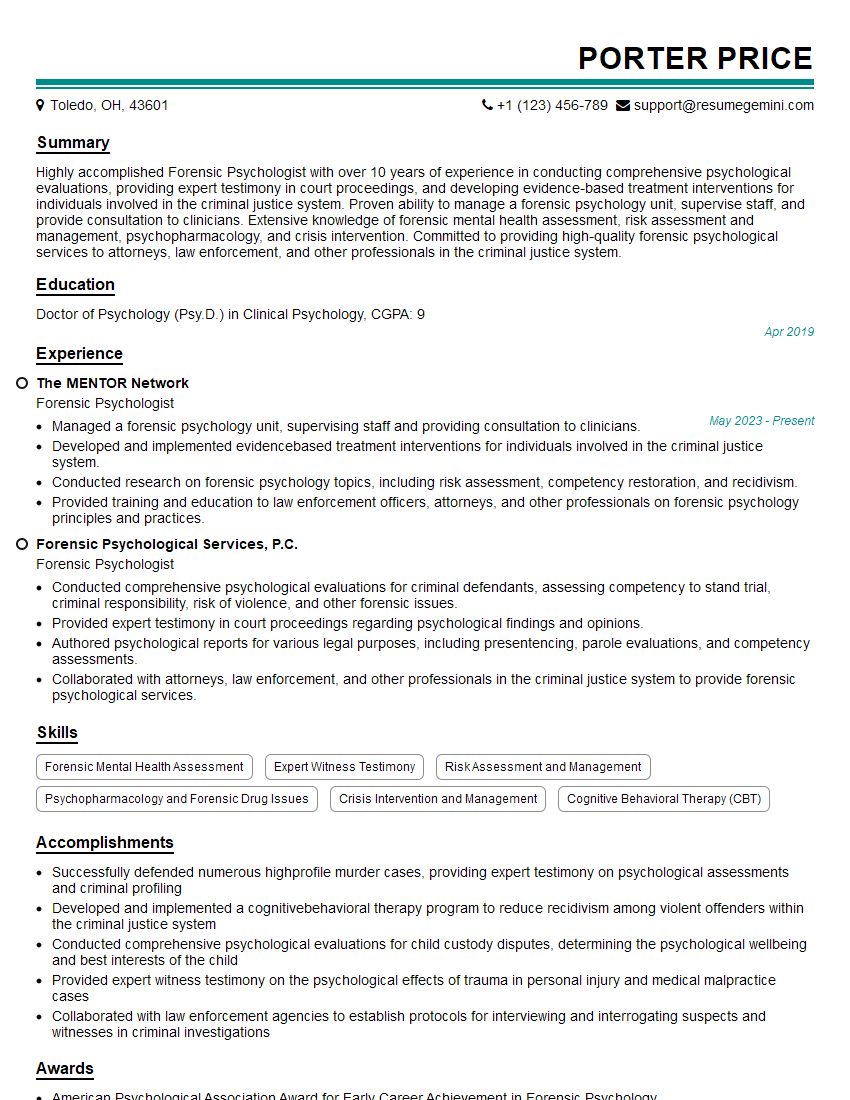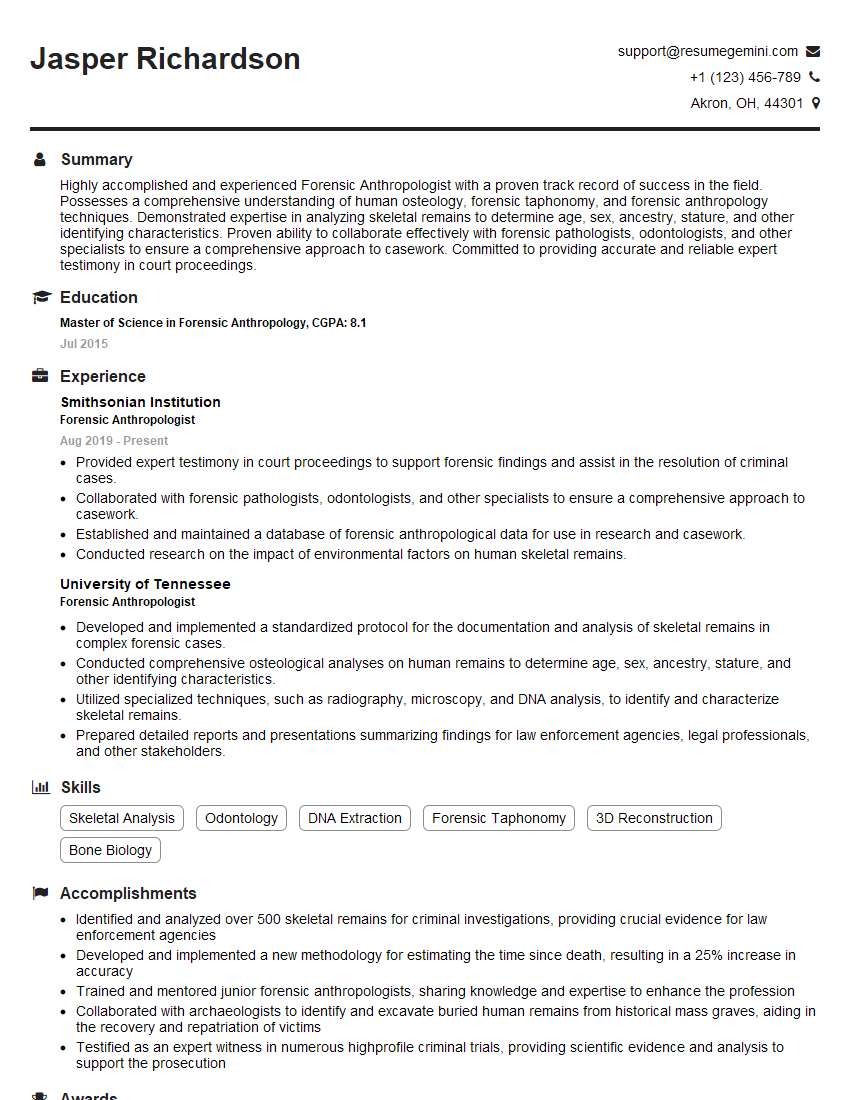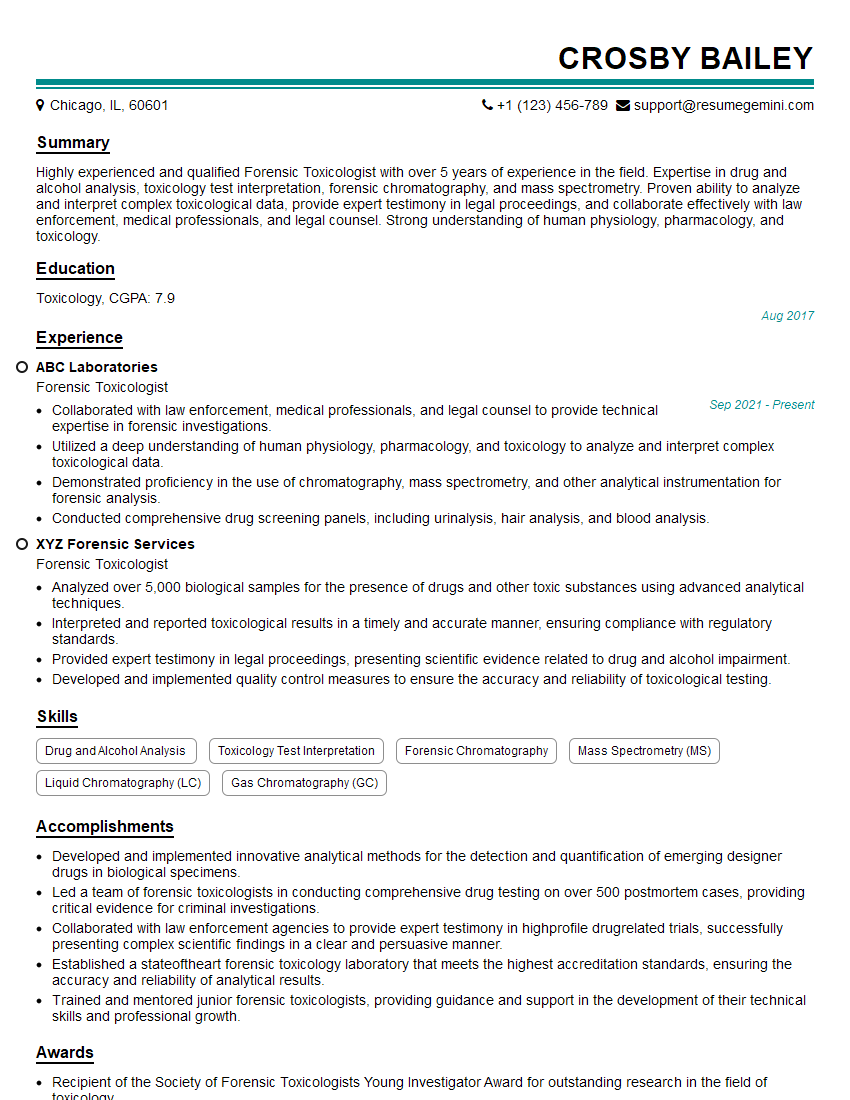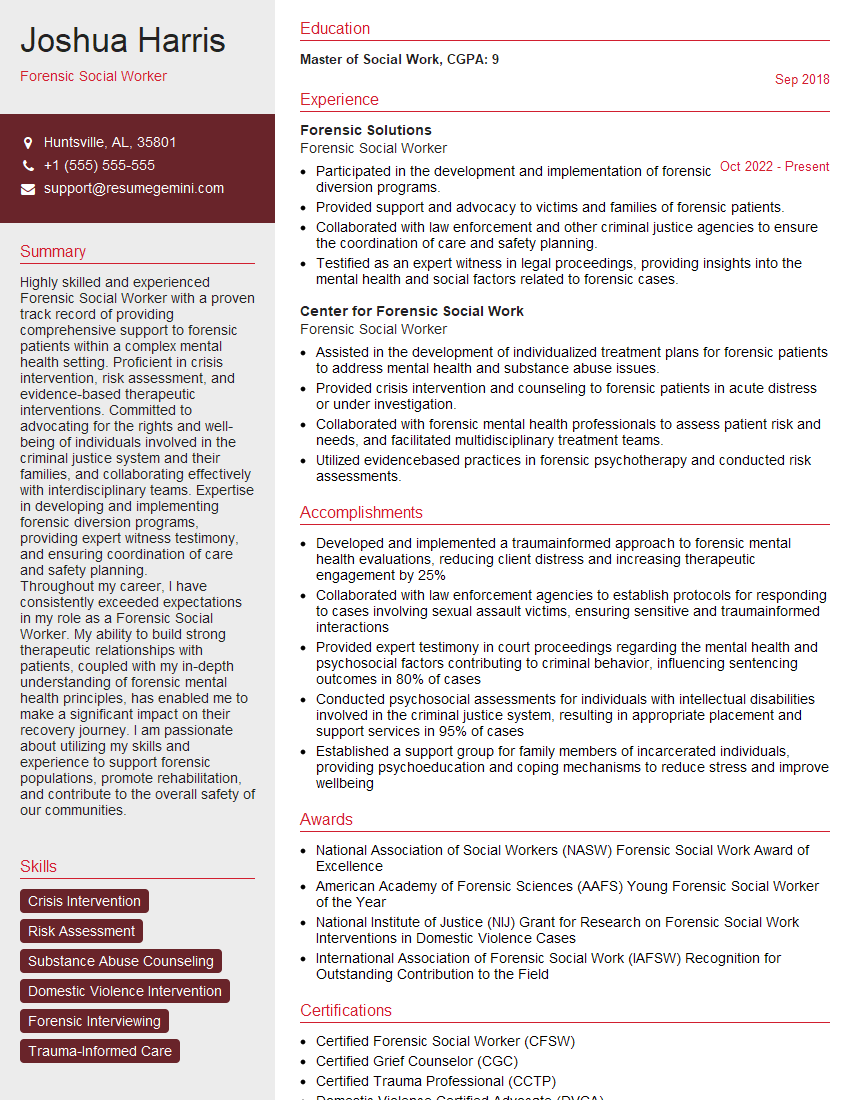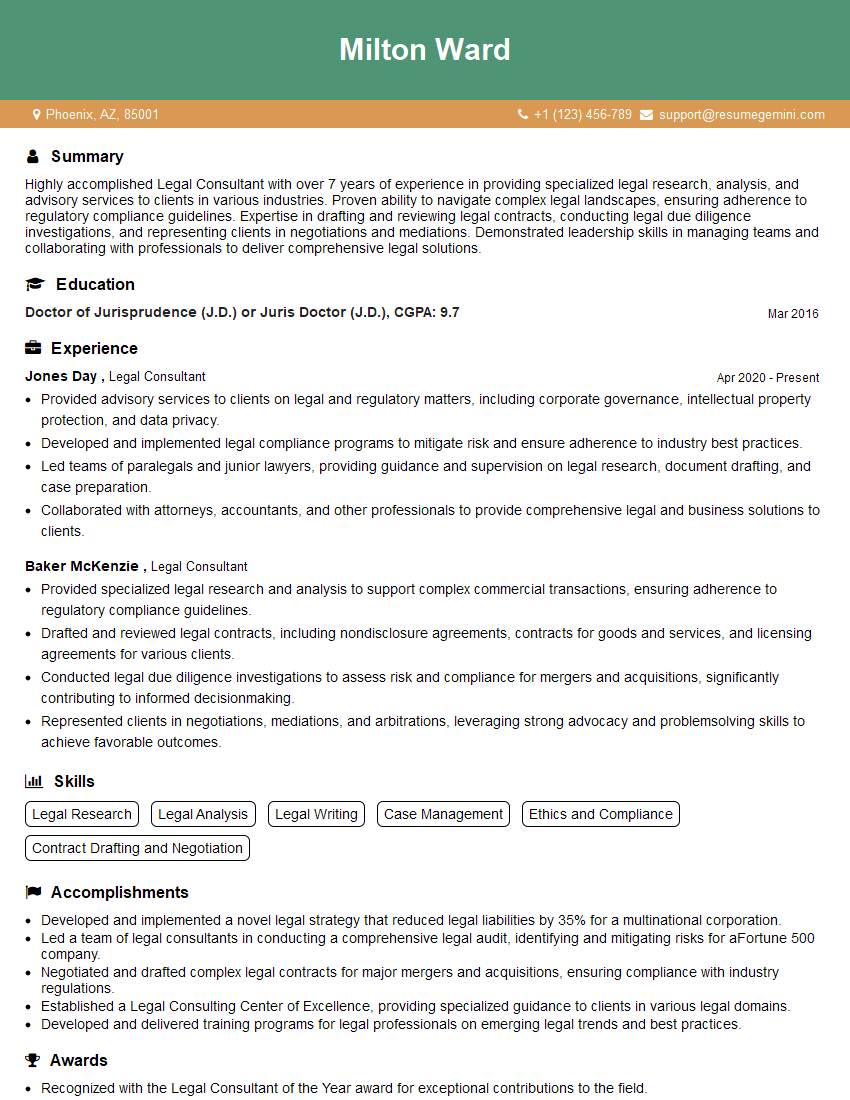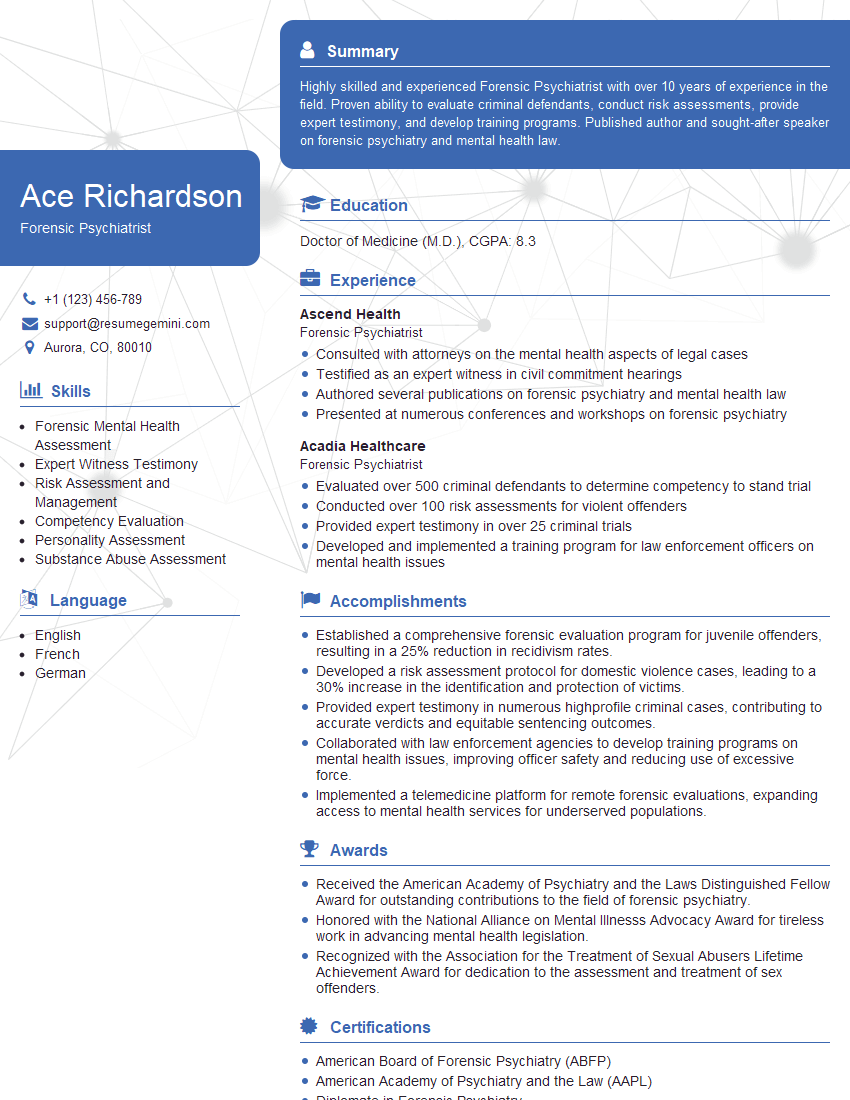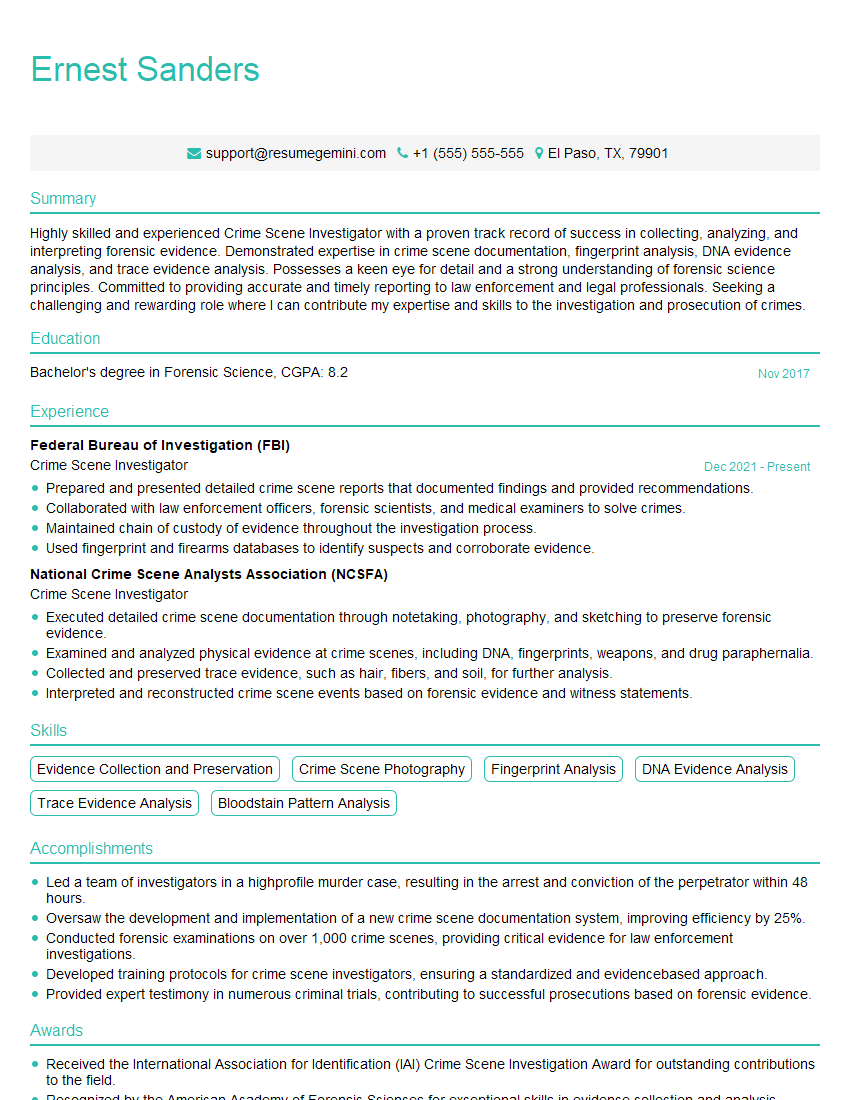Are you ready to stand out in your next interview? Understanding and preparing for Forensic Assessment interview questions is a game-changer. In this blog, we’ve compiled key questions and expert advice to help you showcase your skills with confidence and precision. Let’s get started on your journey to acing the interview.
Questions Asked in Forensic Assessment Interview
Q 1. Explain the difference between a forensic interview and a clinical interview.
The core difference between a forensic interview and a clinical interview lies in their purpose and context. A clinical interview focuses on understanding a client’s mental health, diagnosing conditions, and developing a treatment plan. The relationship is therapeutic, prioritizing the client’s well-being and building rapport. Information is considered confidential, primarily aimed at improving the individual’s mental health.
In contrast, a forensic interview is conducted within a legal context, such as a criminal investigation or a custody dispute. Its primary purpose is to gather information relevant to a legal question, not to provide therapy. The interviewer maintains a neutral stance, aiming for objectivity and accuracy in documenting the information provided. Confidentiality is still crucial, but it is subject to legal requirements and the need for disclosure to relevant parties. For example, information obtained during a forensic interview with a child witness could be shared with law enforcement and the courts.
Think of it this way: a clinical interview is like a doctor’s appointment focusing on treatment, while a forensic interview is like a police interview focusing on evidence gathering.
Q 2. Describe the ethical considerations in conducting forensic assessments.
Ethical considerations in forensic assessments are paramount. They involve adhering to strict codes of conduct, including those established by professional organizations like the American Psychological Association (APA). Key ethical considerations include:
- Confidentiality and Privileged Communication: Understanding the limits of confidentiality, especially when legal mandates require disclosure of information. This balance is crucial as the forensic psychologist is often acting as an expert witness, not a therapist.
- Objectivity and Impartiality: Maintaining an unbiased stance and avoiding personal biases or emotional reactions. Our opinions must be based solely on the available data and professional standards.
- Competence: Only undertaking assessments within one’s area of expertise. We must acknowledge any limitations in our knowledge and refuse cases if the required expertise is lacking.
- Informed Consent: Ensuring individuals understand the purpose, procedures, and implications of the assessment before they agree to participate. This is especially critical when dealing with vulnerable populations.
- Avoiding Conflicts of Interest: Being aware of and avoiding any situations where personal interests might compromise the objectivity of the assessment. For instance, avoiding work that could have implications for prior clients.
- Truthfulness and Accuracy: Reporting findings honestly and accurately, without exaggerating or minimizing information. We must carefully consider possible interpretations when writing our reports.
Breaching any of these ethical standards can severely impact the credibility of the assessment and may have legal ramifications.
Q 3. What are the key elements of a valid and reliable forensic assessment?
A valid and reliable forensic assessment rests on several key elements. Validity refers to whether the assessment actually measures what it is intended to measure. Reliability refers to the consistency of the assessment; similar results should be obtained if the assessment is repeated under similar conditions. Key elements include:
- Appropriate Methodology: Using scientifically sound methods, including standardized tests and structured interviews, that align with the specific legal question.
- Sufficient Data Collection: Gathering comprehensive information from multiple sources, such as interviews, collateral information (from family, friends, etc.), records review (medical, educational, criminal), and psychological testing.
- Clear Definition of the Legal Question: Understanding precisely the issue the assessment is meant to address. The scope of the evaluation should be clear.
- Proper Interpretation of Results: Accurately interpreting the data gathered, considering both quantitative and qualitative information, within the context of the legal issue.
- Well-Documented Report: Producing a clear, concise, and well-organized report that outlines the methodology, findings, and conclusions in a way that is understandable to the legal audience (judges, lawyers, etc.).
Without these elements, the assessment’s value and admissibility in court are severely compromised.
Q 4. How do you ensure objectivity and avoid bias in your assessments?
Objectivity and the avoidance of bias are essential for ethical and legally sound forensic assessments. Here’s how I ensure this:
- Self-Reflection and Awareness: Regularly reflecting on my own biases and potential blind spots. Understanding my own perspectives is the first step in mitigating their impact.
- Use of Standardized Procedures: Employing structured assessments and interviews that minimize subjectivity. Standardized tests offer norms and reduce reliance on personal interpretation.
- Data-Driven Approach: Base my conclusions on the available data, rather than personal beliefs or assumptions. All conclusions must be empirically supported.
- Consultation and Peer Review: Discussing challenging cases with other forensic professionals to gain alternative perspectives and identify potential biases. A second opinion is valuable.
- Transparency in Reporting: Clearly outlining the limitations of the assessment and acknowledging any potential biases in the report. Transparency builds trust and credibility.
- Multiple Methods of Assessment: Combining several assessment methods can help to cross-validate findings and reveal inconsistencies.
For example, in a child custody evaluation, I’d actively work to avoid favoring one parent over another, even if one parent is more engaging or articulate. I rely on objective measures and documented evidence to support my conclusions.
Q 5. Explain the process of conducting a forensic psychological evaluation.
A forensic psychological evaluation is a systematic process. It typically involves the following steps:
- Intake and Referral: Receiving the referral, clarifying the legal question, and obtaining necessary background information.
- Information Gathering: Collecting data from various sources, including interviews with the individual, collateral sources (family, friends, teachers, etc.), reviewing relevant records (medical, educational, criminal, etc.), and administering psychological tests.
- Psychological Testing: Administering appropriate standardized tests, such as intelligence tests (e.g., WAIS-IV), personality tests (e.g., MMPI-2-RF), and clinical interviews.
- Data Analysis and Interpretation: Analyzing the collected data, considering the information from various sources, and integrating findings from the psychological testing.
- Report Writing: Preparing a detailed and objective report that clearly addresses the referral question, outlines the methodology employed, presents the findings, and offers conclusions. The report is written to be understandable for a legal audience and must use legally appropriate terminology.
- Testimony (if necessary): Presenting the findings in court, if required, providing expert testimony, and answering questions from attorneys.
Each step is crucial and must be conducted ethically and rigorously to ensure a valid and reliable assessment.
Q 6. Describe your experience with different assessment tools used in forensic settings.
My experience encompasses a wide range of assessment tools commonly used in forensic settings. These include:
- Intelligence Tests: WAIS-IV, WISC-V, Stanford-Binet – Used to assess cognitive abilities and intellectual functioning, crucial in cases involving competency to stand trial or intellectual disability.
- Personality Tests: MMPI-2-RF, PAI – Provide insight into personality traits, psychopathology, and risk factors, relevant in various contexts, including criminal profiling and custody evaluations.
- Neuropsychological Tests: Luria-Nebraska Neuropsychological Battery, Halstead-Reitan Neuropsychological Battery – Assess cognitive functioning and neurological damage, especially pertinent in cases involving traumatic brain injury or other neurological conditions.
- Forensic-Specific Instruments: Structured interviews for specific legal issues (e.g., assessing malingering or risk of violence).
- Projective Tests: Rorschach Inkblot Test, Thematic Apperception Test (TAT) – While often debated, these can provide valuable qualitative data when interpreted cautiously and with other methods.
The selection of specific tools depends greatly on the referral question and the individual’s specific circumstances. It’s crucial to select tests appropriate for the individual’s age, cognitive abilities, and cultural background.
Q 7. How do you handle cases involving individuals with intellectual disabilities or mental illness?
Individuals with intellectual disabilities or mental illness require specialized approaches in forensic assessments. These individuals often face communication challenges, cognitive limitations, and vulnerabilities that require careful consideration.
- Modified Assessment Procedures: Adjusting assessment methods to accommodate cognitive limitations. This might involve using simpler language, shorter testing sessions, or adapting tasks to the individual’s abilities.
- Collaboration with Specialists: Working in collaboration with other professionals, such as developmental psychologists or psychiatrists, to obtain a comprehensive understanding of the individual’s functioning.
- Consideration of Environmental Factors: Analyzing how the individual’s environment and life experiences might have influenced their behavior. Understanding their context is critical.
- Adaptive Testing: Utilizing adaptive testing methodologies which adjust based on the individual’s responses, allowing more accurate measurement.
- Careful Interpretation of Results: Interpreting results cautiously and considering the potential impact of the individual’s disability or mental illness on test performance. Limitations must be clearly noted.
For example, when assessing a person with schizophrenia for competency, I would carefully consider the effects of their symptoms (such as hallucinations or delusions) on their understanding of the legal proceedings, and use supplemental measures to gain a more holistic view.
Q 8. How do you address challenges related to malingering or deception during an assessment?
Addressing malingering—the intentional feigning of illness or symptoms—and deception in forensic assessments requires a multifaceted approach. It’s not about simply labeling someone a malingerer; it’s about carefully evaluating the consistency and validity of their presentation.
Comprehensive Assessment: I utilize a variety of assessment methods, including standardized psychological tests (like the MMPI-2-RF, which includes validity scales designed to detect malingering), structured clinical interviews, and collateral information from family, friends, or treating professionals. No single test definitively proves or disproves malingering; it’s the convergence of data that’s crucial.
Discrepancy Analysis: I meticulously compare self-reported information with objective data and behavioral observations. For example, a client reporting severe memory impairment might perform exceptionally well on certain cognitive tasks. This discrepancy warrants further investigation.
Symptom Validity Testing (SVT): Specific tests are designed to detect inconsistent or exaggerated symptom reporting. These tests assess effort and response bias, providing objective indicators of potential malingering. Results are always interpreted within the broader clinical context.
Collateral Information: Information gathered from others who know the individual provides valuable context and helps corroborate or refute the client’s self-report. This can significantly help to identify inconsistencies.
Transparency and Rapport: Maintaining a professional yet transparent relationship with the examinee is key. Clearly explaining the purpose of the assessment and the importance of honest responses can sometimes lead to more truthful reporting.
For instance, in a case involving a worker’s compensation claim, a discrepancy between self-reported pain levels and observed functional abilities, coupled with poor performance on SVTs, might suggest exaggeration or malingering. However, I always consider alternative explanations, such as genuine psychological distress or cognitive limitations, before reaching a conclusion.
Q 9. What are the limitations of forensic assessments?
Forensic assessments, while valuable, have inherent limitations. It’s crucial to understand these limitations when interpreting findings and forming conclusions.
Retrospective Nature: Many assessments attempt to reconstruct past events, which relies heavily on memory, which is fallible and susceptible to biases. The further back in time the event, the more unreliable the memory becomes.
Limited Access to Information: We often have a limited perspective. We primarily rely on the individual’s self-report, test results, and available records. We might lack crucial context or information that could alter our interpretation.
Sampling Bias: The assessment sample (the individual being assessed) represents just one person at one point in time. Findings cannot be generalized to other individuals or situations.
Test Limitations: Psychological tests, while powerful tools, are not perfect. They are subject to test-taking biases and cultural factors that could influence the results. No test measures a construct perfectly.
Ethical and Legal Constraints: Confidentiality and ethical considerations might limit the scope and depth of the assessment, thereby limiting conclusions.
For example, in a child custody evaluation, my assessment is based on observations and interviews, which might not fully capture the complexities of the family dynamic. I always clearly state the limitations of my assessment in my report, emphasizing that my conclusions are based on the available data and are subject to these inherent limitations.
Q 10. How do you interpret and report your findings in a forensic assessment?
Interpreting and reporting forensic findings requires a clear, concise, and objective style. The goal is to present the information in a way that is understandable to both legal professionals and laypersons, while avoiding jargon whenever possible.
Data-Driven Approach: My reports are grounded in the data collected, including test results, interview transcripts, and collateral information. I avoid speculation and focus on the empirical evidence.
Clear and Concise Language: The language used is non-technical, avoiding jargon unless absolutely necessary, with any technical terms defined. The report should be readily understandable for a judge or jury.
Structured Format: The report follows a logical structure, typically including a background section, methods, results, and conclusions. This ensures clarity and consistency.
Opinion and Rationale: When providing opinions, I clearly articulate the rationale behind those opinions, citing specific pieces of data and explaining how they support my conclusions.
Limitations: The report explicitly states the limitations of the assessment and its findings. This is crucial for transparency and allows the court to understand the context of the opinions offered.
Imagine a personal injury case. My report would detail the client’s reported symptoms, the results of neuropsychological testing, and any observations made during the interview. My conclusions would be supported by the specific data, acknowledging limitations such as the reliance on self-report and the possibility of symptom exaggeration.
Q 11. Explain your understanding of legal standards and admissibility of evidence in court.
Understanding legal standards and admissibility of evidence is fundamental to forensic assessment. My work must adhere to the rules of evidence, primarily focused on ensuring the reliability and validity of my findings.
Daubert Standard (or equivalent): In many jurisdictions, the Daubert Standard (or similar state rules) governs the admissibility of scientific evidence. This standard emphasizes the reliability and validity of the methodology used, the peer review of the methods, the error rate, and general acceptance within the scientific community.
Relevance: My findings must be relevant to the legal issue at hand. The assessment should address questions directly related to the case.
Probative Value: The evidence must be probative—meaning it has a tendency to make a fact more or less probable than it would be without the evidence.
Prejudicial Effect: The court will consider whether the probative value of the evidence is substantially outweighed by its potential to unfairly prejudice the jury.
I ensure that my methodology is scientifically sound, documented thoroughly, and my conclusions are clearly linked to the evidence. This ensures that my work meets the legal requirements for admissibility and is therefore credible in court.
Q 12. Describe your experience testifying as an expert witness.
I have extensive experience testifying as an expert witness in various legal settings, including family court, civil court, and criminal court. This involves presenting my findings clearly and confidently while being able to withstand rigorous cross-examination.
Preparation: Thorough preparation is essential. I review the relevant case materials, anticipate potential questions, and practice my testimony.
Objectivity: I maintain objectivity, presenting my findings without bias or advocacy for a particular party. My role is to provide the court with unbiased information.
Clear Communication: I communicate complex information in a clear and understandable way, avoiding jargon and using visual aids when appropriate.
Handling Cross-Examination: I am prepared to address challenging questions in a calm and professional manner, sticking to the facts and avoiding speculation.
One case involved a child custody dispute. I presented my assessment findings, emphasizing my methodology and the limitations of my conclusions. During cross-examination, the attorney challenged some of my interpretations, but I was able to confidently defend my conclusions based on the data presented. The experience reinforced the importance of meticulous record-keeping and clear articulation of methodology and findings.
Q 13. How do you maintain confidentiality and comply with legal and ethical requirements?
Maintaining confidentiality and adhering to legal and ethical requirements are paramount. My practice is guided by strict ethical principles and legal mandates.
Informed Consent: Before conducting any assessment, I obtain informed consent from the client, clearly explaining the purpose of the assessment, the limits of confidentiality, and their rights.
HIPAA Compliance (or equivalent): I strictly adhere to HIPAA (Health Insurance Portability and Accountability Act) regulations or equivalent state laws regarding the protection of Protected Health Information (PHI).
Privileged Communication: I understand and respect the concept of privileged communication and its limitations. This varies based on the context of the case and the jurisdiction.
Duty to Warn: In situations where there is a clear and imminent threat of harm to self or others, I have a duty to warn the appropriate authorities.
Ethical Guidelines: My practice is guided by the ethical guidelines of my professional organizations (e.g., APA).
For instance, even when court-ordered, I only release information specifically requested by the court and relevant to the legal proceedings. I always strive to protect client confidentiality to the fullest extent possible while fulfilling my legal and ethical obligations.
Q 14. What are the best practices for documenting forensic assessments?
Comprehensive and meticulous documentation is essential for the validity and defensibility of forensic assessments. This includes detailed record-keeping at every stage of the process.
Detailed Case File: I maintain a complete case file containing all relevant information, including referral information, interview notes, test results, collateral information, and correspondence.
Chronological Order: All documents are maintained in chronological order, allowing for easy tracking of the assessment process.
Objective and Factual Reporting: All entries are objective, factual, and avoid subjective interpretations. Raw data from tests are included alongside interpretations.
Chain of Custody: For any physical evidence, a strict chain of custody is maintained, documenting the handling and transfer of materials.
Secure Storage: Case files are stored securely, adhering to confidentiality and data protection regulations.
A well-documented case file not only ensures the quality of the assessment but also protects me from potential legal challenges. For example, in a custody evaluation, my detailed notes from observations and interviews, along with the raw test data, support the conclusions of the report, making it more easily defensible in court if challenged.
Q 15. Describe your experience working with diverse populations in forensic settings.
Throughout my career, I’ve worked with incredibly diverse populations in forensic settings, including individuals from various socioeconomic backgrounds, cultural heritages, and with diverse levels of education and mental health needs. This diversity necessitates a flexible and culturally sensitive approach to assessment. For example, I’ve conducted evaluations with individuals who are Deaf or hard of hearing, requiring the use of sign language interpreters and careful consideration of communication styles. I’ve also worked with individuals from non-English speaking backgrounds, necessitating the use of qualified translators and ensuring that the assessment process is accessible and understandable. My approach always begins with building rapport and establishing trust, acknowledging cultural differences and adapting my methodology accordingly to ensure a fair and unbiased assessment.
In one specific case, I worked with a client who was a recent immigrant with limited English proficiency. Rather than rely solely on standardized tests which might not accurately capture their abilities due to language barriers, I incorporated alternative assessment methods such as observations of their behavior during unstructured interviews and utilizing drawings and other non-verbal communication techniques. This holistic approach allowed me to obtain a more accurate and comprehensive understanding of their mental state.
Career Expert Tips:
- Ace those interviews! Prepare effectively by reviewing the Top 50 Most Common Interview Questions on ResumeGemini.
- Navigate your job search with confidence! Explore a wide range of Career Tips on ResumeGemini. Learn about common challenges and recommendations to overcome them.
- Craft the perfect resume! Master the Art of Resume Writing with ResumeGemini’s guide. Showcase your unique qualifications and achievements effectively.
- Don’t miss out on holiday savings! Build your dream resume with ResumeGemini’s ATS optimized templates.
Q 16. How do you handle complex or ambiguous cases?
Complex or ambiguous cases require a systematic and methodical approach. I begin by carefully reviewing all available information, including case files, police reports, medical records, and any prior assessments. I then develop a thorough assessment plan that includes a range of methodologies, such as interviews with the individual, collateral interviews with family members or other significant individuals, and the administration of relevant psychological tests. The key is to remain objective, avoid premature conclusions, and to constantly question my assumptions throughout the process.
For example, in a case involving allegations of child abuse where the child’s statements were inconsistent, I used a variety of techniques to gather information, including structured interviews specifically designed for child witnesses and anatomical dolls. By carefully analyzing the data from multiple sources and using a structured approach to evaluating the consistency and plausibility of accounts, I could develop a more complete and nuanced understanding of the situation. This method helps to minimize bias and ensures that I’m drawing conclusions based on the totality of the evidence.
Q 17. How do you maintain your professional competence and stay updated on best practices?
Maintaining professional competence is a continuous process that requires dedication and proactive engagement. I regularly attend professional development workshops and conferences focused on forensic assessment, and I actively participate in continuing education programs to stay abreast of the latest research and best practices. I also regularly review relevant professional literature such as peer-reviewed journals and professional publications to remain updated on new assessment techniques and methodologies. Furthermore, I engage in regular peer supervision and consultation with other forensic professionals to discuss challenging cases and gain valuable insights.
For example, I recently completed a specialized training on the administration and interpretation of the latest revision of the Rorschach Inkblot Test. This training allowed me to enhance my skill set and ensure that I am using the most up-to-date techniques for personality assessment in my forensic practice. I also actively seek out feedback from colleagues and supervisors on my work and strive to continuously improve my skills and knowledge base.
Q 18. What are the common challenges in forensic assessment and how do you overcome them?
Common challenges in forensic assessment include obtaining reliable information from individuals with limited insight or poor memory, navigating ethical dilemmas related to confidentiality and disclosure, and dealing with the inherent limitations of psychological assessment tools. Overcoming these challenges requires careful planning, rigorous methodology, and a strong ethical compass.
For example, when working with individuals who are unwilling or unable to provide accurate information, I employ multiple methods such as collateral interviews and record reviews to corroborate information. When facing ethical dilemmas, I always refer to relevant ethical codes and consult with colleagues or supervisors to ensure that I am making informed and ethical decisions. To address the limitations of assessment tools, I utilize a multimethod approach and carefully consider the strengths and limitations of each technique.
Q 19. Explain your understanding of different types of forensic assessments (e.g., competency, risk assessment).
Forensic assessments encompass a wide range of evaluations designed to address legal questions. Competency to stand trial evaluations assess whether an individual understands the charges against them and can assist in their defense. These assessments examine factors like their ability to understand court proceedings and to communicate effectively with their attorney. Risk assessments evaluate the likelihood of future violent or harmful behavior, often utilizing actuarial instruments and clinical judgment to predict the probability of recidivism. Other types of forensic assessments include evaluations of sanity at the time of the offense, assessments of malingering (faking symptoms), and evaluations related to child custody disputes.
Each assessment type demands a tailored approach. A competency assessment might focus on the individual’s cognitive functioning, whereas a risk assessment might also encompass their social history, past behavior, and clinical diagnosis. The key to success lies in selecting appropriate instruments and integrating information from diverse sources to reach a sound and well-supported conclusion.
Q 20. Describe your experience with specific assessment instruments (e.g., PCL-R, MMPI-2-RF).
I have extensive experience administering and interpreting various assessment instruments, including the Psychopathy Checklist-Revised (PCL-R) and the Minnesota Multiphasic Personality Inventory-2-Restructured Form (MMPI-2-RF). The PCL-R is a widely used instrument for assessing psychopathy, a personality disorder characterized by a lack of empathy and remorse, and manipulative behavior. The MMPI-2-RF is a comprehensive personality inventory that assesses a wide range of personality traits and psychopathology. My training and experience allow me to correctly administer these tests, interpret the results accurately within the context of the individual’s background and history, and to differentiate between genuine psychopathology and malingering.
It’s crucial to remember that these instruments are tools, not definitive answers. I always integrate the results with information gathered from other sources, such as clinical interviews and collateral data, to develop a holistic understanding of the individual. For instance, a high score on the PCL-R alone doesn’t automatically signify a diagnosis of psychopathy; it needs to be interpreted in light of the clinical picture as a whole.
Q 21. How do you integrate information from various sources (e.g., interviews, records, collateral information)?
Integrating information from various sources is a critical aspect of forensic assessment. I utilize a systematic approach, starting with a thorough review of all available documentation. This review allows me to identify any inconsistencies or gaps in information that need further investigation. I then conduct structured interviews with the individual, ensuring that I create a safe and collaborative environment to encourage honest and open communication. Collateral interviews with family members, friends, or other relevant individuals provide valuable insights and help to corroborate or contradict information obtained from other sources.
The process of integration involves careful consideration of the credibility and reliability of each source of information. I consider the potential biases of each informant, the level of their contact with the individual, and their potential motivation for providing certain information. I then weigh the evidence from different sources, looking for patterns and inconsistencies. This process of triangulation helps to build a more complete and accurate picture, enhancing the overall validity and reliability of my assessment.
Q 22. Explain the concept of risk assessment and its application in forensic settings.
Risk assessment in forensic settings is a systematic process of identifying, analyzing, and evaluating the likelihood of future harmful behavior, such as violence or re-offending. It’s not about predicting the future with certainty – that’s impossible – but about understanding the factors that might increase or decrease the probability of such behavior. This information is crucial for making informed decisions about managing risk, for example, in sentencing, parole decisions, or treatment planning.
The process typically involves gathering information from various sources, including interviews with the individual, review of their criminal history, psychological testing, and collateral information from family, friends, or other professionals. This data is then analyzed using structured professional judgment or actuarial tools to generate a risk profile.
For example, a risk assessment might be conducted on an individual convicted of assault to determine the likelihood of future violent acts. This assessment would inform the judge’s sentencing decision and would also guide the development of a treatment plan aimed at reducing the individual’s risk of re-offending.
Q 23. What are the factors you consider when assessing risk of violence or re-offending?
When assessing the risk of violence or re-offending, I consider a wide range of factors, categorized broadly as:
- Historical Factors: These are past behaviors, such as previous convictions, history of violence, and substance abuse. For instance, a history of multiple violent offenses is a strong indicator of future risk.
- Clinical Factors: These include mental health diagnoses, such as antisocial personality disorder or psychopathy, as well as substance abuse problems. Untreated mental health conditions can significantly increase risk.
- Situational Factors: These are aspects of the individual’s current life circumstances that may influence their behavior. This includes things like access to weapons, social support, employment status, and housing stability. Lack of stable housing or employment can significantly increase risk.
- Dynamic Factors: These are changeable aspects of the individual’s personality and behavior that can be influenced by intervention. Examples include attitudes towards violence, empathy levels, and self-control. Changes in these factors can reflect reduced risk.
I use a combination of structured professional judgment and actuarial instruments, like the Historical, Clinical, Risk Management-20 (HCR-20) or the Violence Risk Appraisal Guide (VRAG), to integrate this information. No single factor determines risk; it’s the interplay of these multiple factors that shapes the overall assessment.
Q 24. How do you communicate complex information to non-experts, such as judges or juries?
Communicating complex information to non-experts requires clear, concise, and jargon-free language. I avoid technical terms or define them clearly when necessary. I use analogies and real-world examples to illustrate complex concepts. Visual aids like graphs or charts can help to simplify data presentation.
For example, instead of saying “The individual exhibits high psychopathy scores,” I might explain, “The tests suggest the individual has traits that make them more likely to be manipulative and disregard the rights of others.” I also focus on the implications of the findings for the court’s decision, emphasizing the relevance and practical significance of the assessment.
I prepare a written report that is detailed yet accessible, and I’m always prepared to answer questions in a way that can be easily understood. The goal is to ensure the judge or jury understands the assessment’s findings and their implications without being overwhelmed by technical details.
Q 25. Describe your experience with different types of forensic cases (e.g., criminal, civil, child custody).
My experience encompasses a broad range of forensic cases. In criminal cases, I’ve conducted risk assessments for sentencing, parole hearings, and fitness to stand trial evaluations. I’ve worked on civil cases involving personal injury claims, where assessments focused on the plaintiff’s psychological damages. In child custody cases, I’ve evaluated the parenting capabilities of individuals involved, focusing on the child’s best interests.
For instance, in a child custody case, I conducted a comprehensive assessment of both parents, including interviews, observations of parent-child interactions, and review of relevant documents. My report addressed each parent’s capacity for providing a stable and nurturing environment, considering factors such as their emotional stability, parenting styles, and the child’s expressed preferences (where age-appropriate). In a criminal case involving a defendant accused of domestic violence, I conducted a risk assessment to determine the probability of future violence toward the victim. This involved a thorough analysis of their history of violence, mental health status, and risk factors, ultimately informing recommendations for sentencing and post-release supervision.
Q 26. How do you manage your time effectively when conducting multiple assessments concurrently?
Managing multiple concurrent assessments requires meticulous organization and time management. I use a project management approach, employing tools like digital calendars, task lists, and dedicated files for each case. This allows me to track deadlines, allocate time effectively, and ensure that all assessments are completed thoroughly and within the required timeframe.
Prioritization is crucial. I identify the most urgent assessments based on deadlines and legal requirements. I allocate specific blocks of time for each case, minimizing interruptions and maximizing focus. I regularly review my schedule to identify potential conflicts and adjust as needed. This proactive approach prevents delays and ensures the quality of my work across all cases.
Q 27. Describe a challenging case you faced and how you successfully navigated it.
One particularly challenging case involved a young adult accused of arson with a history of severe childhood trauma and untreated mental illness. Initial assessments suggested a high risk of re-offending, but his seemingly genuine remorse and cooperation during therapy raised questions. The challenge was reconciling the high historical risk with the positive changes observed during treatment.
I navigated this by using a more nuanced approach, incorporating dynamic risk factors into my assessment. I collaborated closely with the treatment team to monitor his progress and conduct follow-up assessments. This involved reviewing his progress notes, conducting interviews, and administering additional psychological tests to gauge the sustainability of his positive changes. Ultimately, my report highlighted the complexity of the case, acknowledging both the high historical risk and the significant progress made through treatment, resulting in a recommendation for a structured rehabilitation program rather than strict incarceration.
Q 28. How do you stay abreast of changes in legislation relevant to forensic assessment?
Staying current with relevant legislation is vital for maintaining the accuracy and legal validity of my assessments. I subscribe to professional journals such as the Journal of Forensic Psychiatry and Psychology, attend relevant conferences and workshops, and actively participate in professional organizations like the American Psychology-Law Society. I also monitor legislative updates through government websites and legal databases to remain informed about changes to laws concerning risk assessment, mental health legislation, and evidence admissibility. Continuous professional development is essential in ensuring my practice remains current and legally sound.
Key Topics to Learn for Forensic Assessment Interview
- Forensic Psychology Principles: Understanding the fundamental principles of forensic psychology, including ethical considerations and legal frameworks relevant to assessment.
- Assessment Methods: Mastering various assessment techniques, such as clinical interviews, psychological testing (e.g., personality inventories, intelligence tests), and forensic-specific instruments. Practical application: Knowing when to apply specific tests based on the referral question and the individual’s presentation.
- Risk Assessment and Management: Developing proficiency in evaluating risk factors and implementing appropriate risk management strategies. Practical application: Analyzing case studies to identify potential risks and suggest interventions.
- Report Writing and Testimony: Gaining expertise in writing clear, concise, and legally sound forensic reports, and preparing for potential courtroom testimony. Practical application: Structuring a report to address the specific legal questions and presenting findings in a clear and understandable manner.
- Specific Populations: Familiarizing yourself with the assessment needs of specific populations, such as juveniles, individuals with intellectual disabilities, or those experiencing trauma.
- Ethical and Legal Considerations: Deep understanding of ethical guidelines and legal standards governing forensic assessment practice. This includes confidentiality, informed consent, and the potential impact of biases in assessment.
- Case Conceptualization and Formulation: Developing the ability to integrate information from various sources (e.g., interviews, test results, collateral information) to create a comprehensive understanding of the individual and their situation.
- Critical Thinking and Problem-Solving: Honing your ability to critically analyze information, identify biases, and develop sound conclusions based on available data. Practical application: Presenting alternative hypotheses and evaluating their plausibility.
Next Steps
Mastering forensic assessment is crucial for career advancement in this specialized field. A strong understanding of these key areas will significantly enhance your interview performance and open doors to exciting opportunities. To maximize your job prospects, creating an ATS-friendly resume is essential. ResumeGemini is a trusted resource that can help you build a professional and impactful resume tailored to the specific requirements of forensic assessment roles. Examples of resumes tailored to Forensic Assessment are available within ResumeGemini to guide you.
Explore more articles
Users Rating of Our Blogs
Share Your Experience
We value your feedback! Please rate our content and share your thoughts (optional).
What Readers Say About Our Blog
This was kind of a unique content I found around the specialized skills. Very helpful questions and good detailed answers.
Very Helpful blog, thank you Interviewgemini team.




